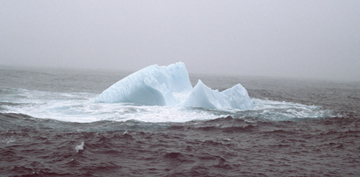Like the icemaker in your fridge, the cold waters of the Arctic are constantly making chunks of ice. Most of them simply circle around the Arctic before they run aground. But a few survive to reach the North Atlantic shipping lanes.
 Iceberg off the coast of Newfoundland. Credit: NASA
Iceberg off the coast of Newfoundland. Credit: NASAEstimates put the number of Arctic icebergs per year at 30,000 and up. They come from glaciers — vast sheets of ice that sit atop land. The weight of the ice itself squeezes it toward the ocean, where waves and tides break off chunks to form icebergs — a process known as “calving.” Most of the chunks are small — only a few feet of ice extend above the ocean surface. But some are giants, extending hundreds of feet skyward, with most of their massive bulk below the surface.
The bergs in the Arctic Ocean itself are calved from the glaciers of Canada, Russia, Alaska, and Norway. Few of these ever escape the Arctic. And of those that do leave Arctic waters, almost all enter the North Atlantic. On the Pacific side they’re hemmed in by the narrow Bering Strait and the Aleutian Islands.
The ones that escape the Arctic Ocean are joined by bergs from the largest source in Arctic climes — the glaciers of Greenland. Thousands of bergs break off each year. They’re carried southward by the Labrador Current, which stays cold enough that the icebergs survive to enter the North Atlantic, where they can threaten shipping. Spurred by the loss of the Titanic, the International Ice Patrol has been keeping watch on these bergs since 1914 — protecting ships from the Arctic icemaker.

